#Battle of Kadesh
Text
youtube
Battle of Kadesh, 1274 BC --- Clash of Ancient Superpowers
from HistoryMarche
28 notes
·
View notes
Text
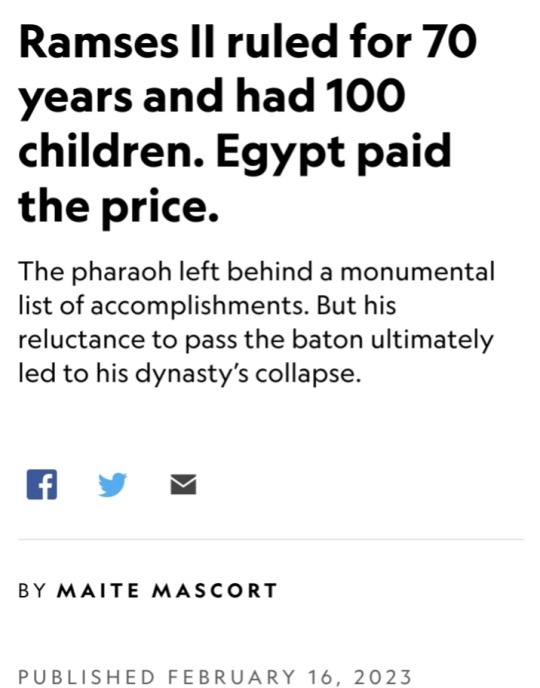

Few individuals in Egypt’s history have aroused as much curiosity, and as much skepticism, as Ramses II, third pharaoh of the 19th dynasty, whom history dubbed Ramses the Great.
Today, Ramses II is probably best known for leaving behind a monumental set of works — palaces, temples, statues, stelae — each one extolling his pharaonic achievements.
Every battle was a mighty triumph, every building spectacular, every statue and public work magnificent, every act a near superhuman achievement.
Ramses’ family came to power as outsiders.
They were northerners hailing from the Nile Delta and rose through military service, rather than southerners rising from elite circles in Thebes.
To rally support, Ramses II used these massive monuments to appeal to the people as part of a campaign to proclaim his greatness for all to see.
Ramses lived around 90 years and ruled for almost 70.
Thanks to his building campaigns, Egyptologists know much about his public accomplishments, but questions about his wives and children still remain.
Great royal wives
One of the most striking aspects of Ramses II’s story is the women who surrounded him:
Great royal wives and concubines, secondary wives and daughters, whom he sometimes “married,” for political show or perhaps for real.
He produced an extraordinary number of sons and daughters:
Some records say as many as a hundred. Because of his long reign, many of his children predeceased him.

Out of all of his wives, only two were known to have had prominent roles:
Nefertari and Isetnofret, the first two named great royal wives.
While the former figures prominently in Egyptian sources and countless representations of her exist, little is known of the latter, almost as if Ramses wanted her hidden.
It is only natural to wonder about the reasons for such unequal treatment.
When he became co-regent with his father, Seti I, Ramses II received a palace in Memphis, just south of the Nile Delta, and a large harem, including the first two great royal wives.
The origins of Nefertari and Isetnofret are unknown but that has not prevented the wildest of speculation about them.
Everything suggests that Nefertari was Ramses II’s favorite wife. Her beauty is attested to in the statues and paintings in her tomb in the Valley of the Queens.
However, it is uncertain what she actually looked like, since some images raise doubts about who is depicted.

For example, in Karnak, a small statue of Nefetari stands at the foot of a colossus representing Ramses II, her husband.
The colossus was later usurped by Pharaoh Pinedjem I, who had his name inscribed on it, and the features of both figures may have been modified.
Was only the name changed? Is that beautiful face still Nefertari’s? Egyptologists believe so.
Nefertari took part in official events alongside Ramses.
She was shown celebrating his coronation, in festivities of the god Min, and in Nebunenef’s enthronement as High Priest of Amun.
Her diplomacy culminated in a peace treaty between Ramses and the Hittites several years after the Battle of Kadesh (1274 B.C.) had resulted in a stalemate between the two powers.
Ramses II showed a clear predilection for Nefertari, devotion worthy of a great love story.
When he built the great temple of Abu Simbel, he made sure that Nefertari, then deceased, was on the facade, next to Tuya, his mother.

In this temple, Nefertari is transformed into Sopdet, the star Sirius, whose appearance presaged the Nile’s annual flooding.
Farther north, another smaller temple dug into rock is dedicated to Nefertari herself.
There, she is identified with the goddess Hathor. Carved into its facade is a tribute:
“Nefertari, she for whom the sun shines.”
Was Isetnofret the forgotten one? So it seems.
Until Nefertari died, around year 26 of Ramses II’s reign, Isetnofret’s likeness did not appear in the many temples the king built in Nubia, nor in those in Karnak and Luxor, where Nefertari is often portrayed.
Isetnofret was finally represented in some temples for her connection with her children.
Nefertari’s image may be seen in more places, but it was Isetnofret who bore her husband the two children closest to his heart.

Sons and daughters
Ramses II had a hundred or so sons and daughters with the wives in his harem.
Of his recognized children, some would play important roles, but only those born to Nefertari and Isetnofret appear on his monuments.
In the Nubian temple of Beit el Wali, a young Ramses, then co-regent with his father, Seti I, is shown suppressing a Nubian uprising.
The pharaoh’s royal chariot is flanked by two figures identified as Amenherkhepshef, his eldest child with Nefertari, and Khaemwaset, Isetnofret’s son.
Of all Ramses II’s sons, Khaemwaset is believed to have been his favorite.
Instead of taking up arms against his elder brother (also named Ramses), Khaemwaset became Grand Master of the Artisans of Ptah, a title in Memphite doctrine equivalent to High Priest of Amun in Thebes.
He also restored a number of pyramids in his father’s name. His work is still evident on the pyramid of Unas, from the 5th dynasty.
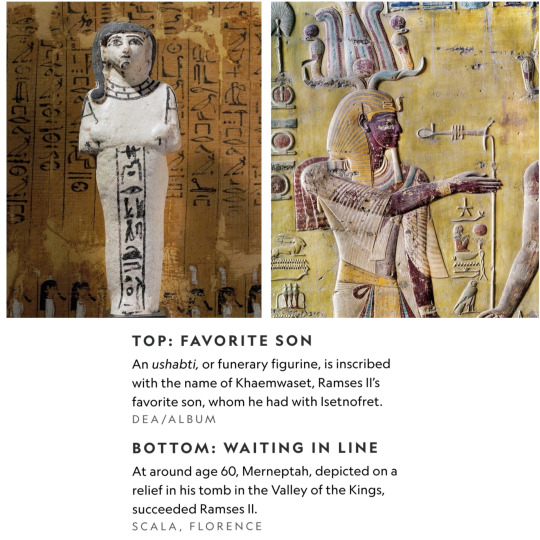
Khaemwaset also planned and directed the work of the “minor galleries,” the Serapeum at Saqqara, the collective tomb of the Apis, sacred oxen of Memphis.
Auguste Mariette’s 1850 excavation of the Serapeum revealed the mummy of a man named Khaemwaset, wearing a golden mask with several ushabtis.
It proved uncertain that it was the mummy of Ramses II’s son, and the location of Khaemwaset’s tomb remains unconfirmed. Much evidence suggests that it is in the necropolis of Saqqara.
The daughters of Ramses II’s great royal wives also held key positions in his court.
In fact, many became great royal wives themselves after marrying their own father.
It had become customary for 18th-dynasty pharaohs to marry their daughters.
While his great royal wife Tiye was alive, Amenhotep III married their daughter Sitamun.
Later, Akhenaten married at least two of the daughters he had with Queen Nefertiti.
No one knows if these marriages were consummated or purely ceremonial.

Ramses II appointed several daughters / great royal wives after the deaths of Nefertari and Isetnofret.
Bintanah (Isetnofret’s firstborn) was followed by Merytamon and Nebettawy (daughters of Nefertari) and Henutmire.
In addition to these daughters, other princesses outside the family also bore the title of Great Royal Wife, such as Maathorneferure, daughter of the Hittite king, and another Hittite princess whose name is unknown.
If Khaemwaset was Ramses II’s favorite son, everything points to Bintanath having been his preferred daughter.
She was given the titles of not only Great Royal Wife but also Lady of the Two Lands and Sovereign of Upper and Lower Egypt.
Bintanath occupies a privileged place on the facade of the temple of Abu Simbel. She and her sister Nebettawy appear on either side of the colossus.
Some historians believe Nebettawy’s mother was Isetnofret, but others consider her Nefertari’s daughter.
Fractured legacy
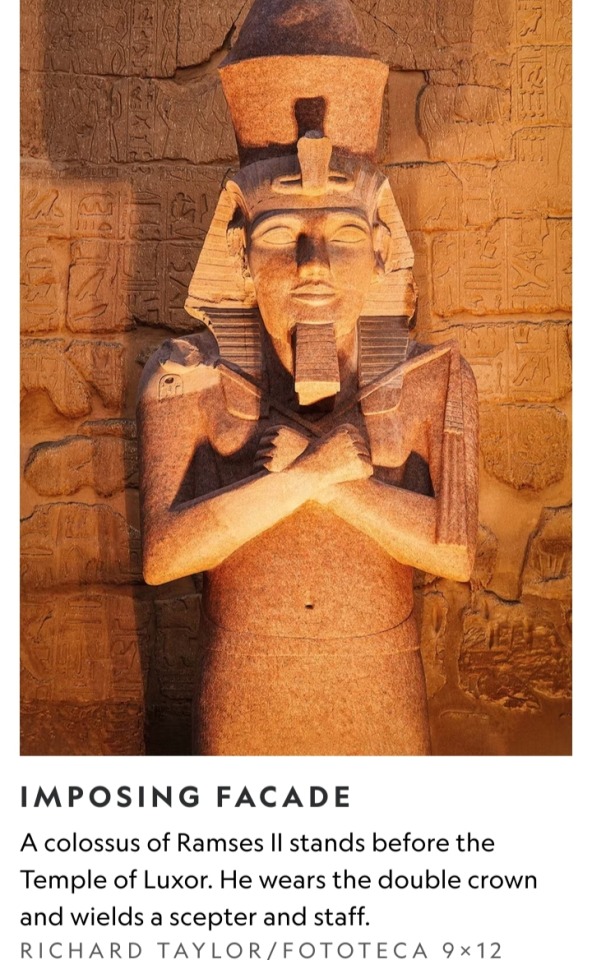
Ramses had no problems siring heirs with his many wives during his long life, but these sons would be forced to be patient; their father held tightly to his throne for almost 70 years.
Ramses had placed his children liberally throughout Egypt’s bureaucracies, corporations, priesthood, and military to foster loyalty he did not naturally inspire.
He was an outsider, a northerner hailing from the Nile Delta, disconnected from the wealthy elites in southern Thebes.
Ramses’ source of strength rested on ties to, not the moneyed or religious classes, but the military. Placing his sons in powerful positions across Egypt helped strengthen Ramses’ hold in these areas.
By the time Ramses II died in 1213 B.C., he was around 90 years old and had outlived many of these sons.
Amenherkhepshef, Ramses’ oldest son and crown prince, died when he was 25 years old.
Khaemwaset also did not outlive his great father and died in his mid-50s around 1215 B.C.
It would be a child of Isetnofret, her son Merneptah, who was 13th in line, who succeeded Ramses.
Merneptah was around 60 years old, well past middle age, when he became pharaoh and donned Egypt’s double crown.
After decades of waiting in the wings to take power, Merneptah might have expected a stable reign, like his father’s, but his hopes were in vain.
During his 10-year reign, his troops were able to defend Egypt successfully from a series of attacks from enemies in the east and west.
But the seeds sown by Ramses II would lead to chaos after Merneptah’s death.
Rivals for the throne, some of whom may have been sons of Ramses II, pushed Egypt into a period of decline and civil war.
By around 1189 B.C., the 19th dynasty would come to an end.

#Ramses II#Ramses the Great#Nefertari#Isetnofret#Seti I#Valley of the Queens#Pharaoh Pinedjem I#Hittites#Battle of Kadesh#Abu Simbel#Tuya#Amenherkhepshef#Khaemwaset#Auguste Mariette#Bintanath#Ancient Egypt#Egyptian Civilization#Egypt#egyptologist#Egyptology#Nineteenth Dynasty of Egypt#19th Dynasty of Egypt
19 notes
·
View notes
Text
The Egyptian Dream Book | Ancient Origins
https://www.ancient-origins.net/myths-legends/egyptian-dream-book-001621
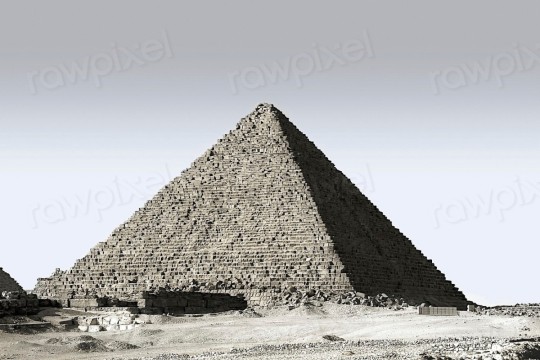
View On WordPress
#Amennakht#Battle of Kadesh#bible#Book of Genesis#Deir el-Medina#Divination#Egypt#Egyptian Dream Book#Jacob#Jewish Patriarchs#Joseph#Khaemamer#Oneiromancy#Pharaoh#Qeniherkhepshef#Ramesses II#Valley of the Kings
0 notes
Text

Last night’s stinky writing session: Ninurta can’t resist taking a shot at the Hurrian gods.
Siege of Aleppo comic.
#bronze gods#pantheon#bronzegods#mythological fiction#ninurta#tessub#hurrian#The pantheon universe is a series of comic strips so this is how I write them in preparation for the comic#lore#This is actually set after the Battle of Kadesh story#it’s the Seige of Aleppo that happens when Assyria makes eyes at aleppo while Hatti and Mitanni are exhausted from fighting Egypt#text corpus
0 notes
Text
Here's the chariot of Ramses II, from a temple carving glorifying his “victory” at Kadesh, with horses depicted at a gallop so fast they might as well be flying:

{Buy me a coffee} {WHF} {Medium} {Looking Through the Past}
Much more on the battle of Kadesh here:
160 notes
·
View notes
Photo
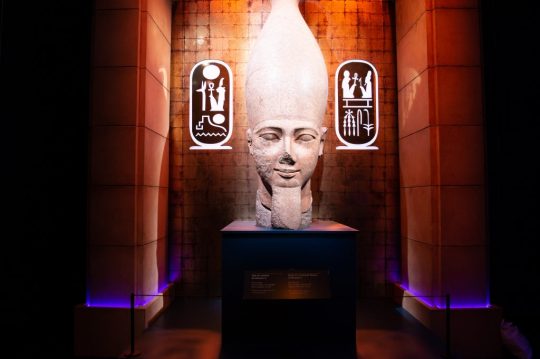
Egyptian Pharaoh Ramses II’s Statues and Treasures now on Exhibition in Paris
Many of the more than 180 objects have never left Egypt before.
From whichever angle you approach Ramses II, the 13th century B.C.E pharaoh earns his epithet: the Great.
His 67-year reign stands as the second longest in Egyptian history. Bold in both war and peace, Ramses expanded Egyptian territory and signed the earliest-known peace treaty with the Hittites in 1271 B.C.E. This consolidation led to an unparalleled building of cities and monuments—often to himself. Ramses’s progeny was also vast, he’s estimated to have fathered more than 100 children.
There may have been 11 other pharaohs named Ramses, but “Ramses and the Gold of the Pharaohs,” a recently opened show in Paris demonstrates the pharaoh who acquired semi-godlike status in his own lifetime needs no identifiers.
The exhibition is on the third leg of a five-year, 10-city global tour with previous stops at Houston Museum of Natural Science and San Francisco’s de Young Museum. It was devised through a collaboration between the Supreme Council of Antiquities of the Arab Republic of Egypt and World Heritage Exhibitions.

Across more than 180 objects, many of which have never before left Egypt, the show creates a vivid picture of the country’s ancient Golden Age. Though Ramses’s tomb in the Valley of the Kings was raided and plundered of its gold adornments, the show presents ample treasures directly connected to him including a colossal red granite statue of the pharaoh’s head, one of his many gold rings, and painted reliefs celebrating his military victories.
More broadly, the exhibition presents a view of the world Ramses inhabited, sculpted, and inspired. There is space dedicated to the grave of royal tomb builder Sennedjem, a collection of mummified animals found at the Saqqara necropolis, and treasures discovered in the royal tombs in Dahshur and Tanis.
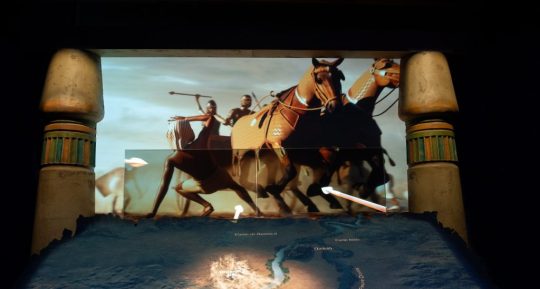
The exhibition also leans on contemporary technology to bring both artifacts and historical events to life. Drone footage and computer animations have been used to recreate the ancient splendor of Ramses’s memorial temple, photo-murals are projected on walls, and there’s a multimedia recreation of the Battle of Kadesh, a 1274 B.C.E. chariot battle widely considered the pharaoh’s greatest military achievement. There is also a V.R. experience available to visitors.
“Ramses II is considered to be the greatest king ever to rule Egypt,” said Mostafa Waziri, Egypt’s Secretary-General of the Supreme Council of Antiquities in a press statement. “This exhibition will illuminate the pivotal moments that earned the great pharaoh his place in history, while bringing visitors face-to-face with absolutely stunning Egyptian artifacts”.
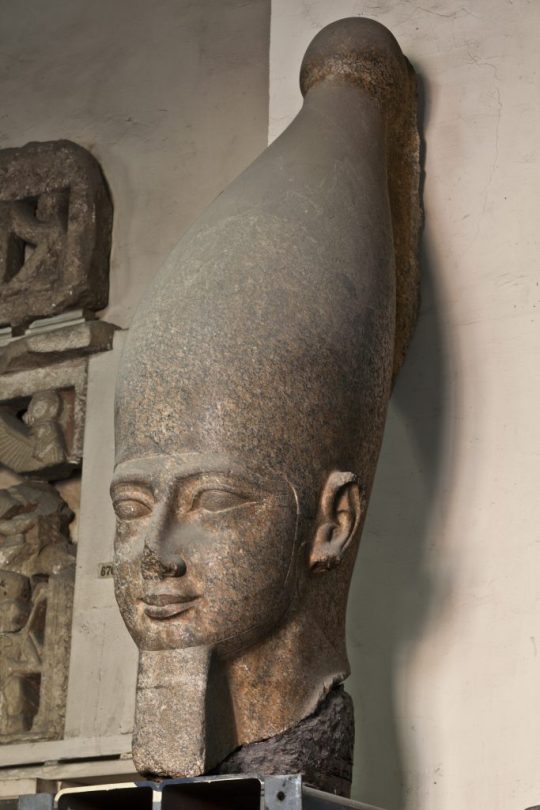


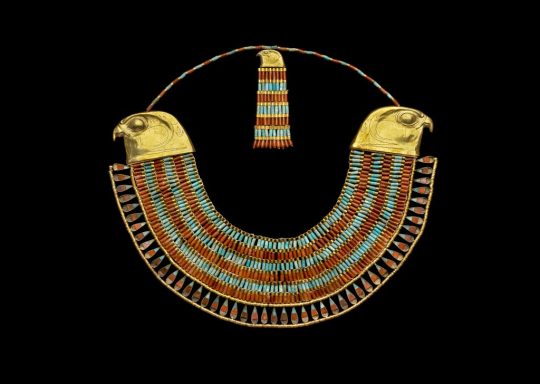




#Egyptian Pharaoh Ramses II#Egyptian Pharaoh Ramses II’s Statues and Treasures now on Exhibition in Paris#ancient artifacts#egyptian artifacts#history#history news#ancient history#ancient culture#ancient civilizations#ancient egypt#egyptian history#egyptian art#egyptian pharaoh
202 notes
·
View notes
Text
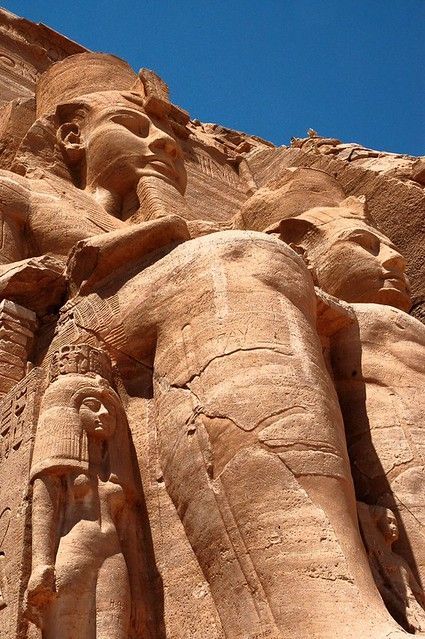
Abu Simbel is a historic site comprising two massive rock-cut temples in the village of Abu Simbel (Arabic: أبو سمبل), Aswan Governorate, Upper Egypt, ...
The twin temples were originally carved out of the mountainside in the 13th century BC, during the 19th Dynasty reign of the Pharaoh Ramesses II. They serve as a lasting monument to the king Ramesses II. His wife Nefertari and children can be seen in smaller figures by his feet, considered to be of lesser importance and were not given the same position of scale. This commemorates his victory at the Battle of Kadesh. Their huge external rock relief figures have become iconic.
The complex was relocated in its entirety in 1968 as part of the International Campaign to Save the Monuments of Nubia, under the supervision of a Polish archaeologist, Kazimierz Michałowski, from the Polish Centre of Mediterranean Archaeology University of Warsaw
234 notes
·
View notes
Text

King Ramesses II on his chariot – Battle of Kadesh
New Kingdom, 19th Dynasty, ca. 1274 BC.
Relief from inside the Great Temple of Ramesses II at Abu Simbel.
The battle of Kadesh is one of the world’s largest chariot battles, fought beside the Orontes River, King Ramesses II sought to wrest Syria from the Hittites and recapture the Hittite-held city of Kadesh. There was a day of carnage as some 5,000 chariots charged into the fray, but no outright victor.
Read more
51 notes
·
View notes
Text
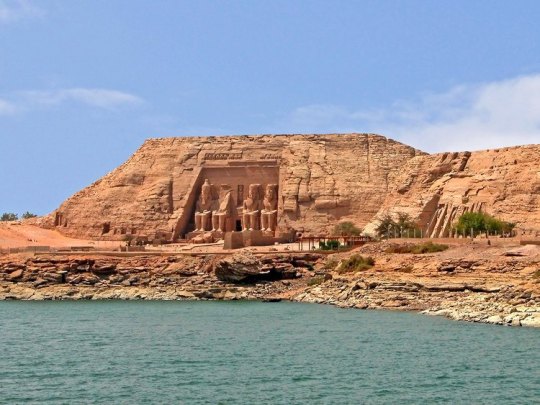
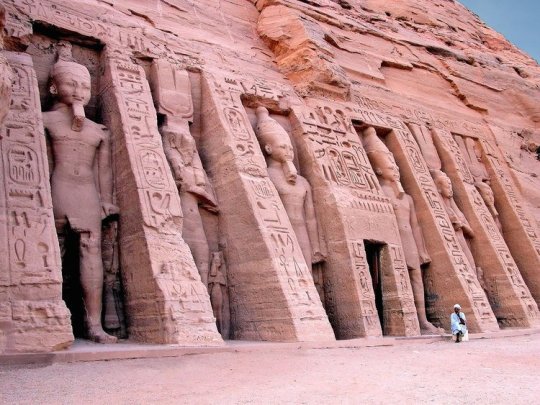
ABU Simbel is an ancient temple complex, originally cut into a solid rock cliff, in southern Egypt and located at the second cataract of the Nile River. The two temples which comprise the site were created during the reign of Ramesses II (c. 1279 - c. 1213 BCE) either between 1264 - 1244 BCE or 1244-1224 BCE. The discrepancy in the dates is due to differing interpretations of the life of Ramesses II by modern-day scholars.
It is certain, based upon the extensive artwork throughout the interior of the Great Temple, that the structures were created, at least in part, to celebrate Ramesses' victory over the Hittites at the Battle of Kadesh in 1274 BCE. To some scholars, this indicates a probable date of 1264 BCE for the initial construction as the victory would have been fresh in the memory of the people. However, the decision to build the grand monument at that precise location, on the border with the conquered lands of Nubia, suggests to other scholars the later date of 1244 BCE in that it would have had to have been begun after the Nubian Campaigns Ramesses II undertook with his sons and was built as a symbol of Egypt's power.
Read more here
179 notes
·
View notes
Text

Abram Rescues Lot
1 And it came to pass in the days of Amraphel king of Shinar, Arioch king of Ellasar, Chedorlaomer king of Elam, and Tidal king of nations,
2 that these made war with Bera king of Sodom, and with Birsha king of Gomorrah, Shinab king of Admah, and Shemeber king of Zeboiim, and the king of Bela, which is Zoar.
3 All these were joined together in the Vale of Siddim, which is the Salt Sea.
4 Twelve years they served Chedorlaomer, and in the thirteenth year they rebelled.
5 And in the fourteenth year came Chedorlaomer and the kings that were with him, and smote the Rephaim in Ashteroth Karnaim, and the Zuzim in Ham, and the Emim in Shaveh Kiriathaim,
6 and the Horites in their Mount Seir, unto Elparan, which is by the wilderness.
7 And they returned and came to Enmishpat, which is Kadesh, and smote all the country of the Amalekites and also the Amorites, who dwelt in Hazezontamar.
8 And there went out the king of Sodom, and the king of Gomorrah, and the king of Admah, and the king of Zeboiim, and the king of Bela (the same is Zoar), and they joined battle with them in the Vale of Siddim,
9 against Chedorlaomer the king of Elam, and against Tidal king of nations, and Amraphel king of Shinar, and Arioch king of Ellasar – four kings against five.
10 And the Vale of Siddim was full of slime pits; and the kings of Sodom and Gomorrah fled and fell there, and those who remained fled to the mountain.
11 And they took all the goods of Sodom and Gomorrah and all their victuals, and went their way.
12 And they took Lot, Abram's brother's son, who dwelt in Sodom, and his goods and departed.
13 And there came one who had escaped, and told Abram the Hebrew, for he dwelt on the plain of Mamre the Amorite, brother of Eshcol and brother of Aner; and these were confederate with Abram.
14 And when Abram heard that his brother was taken captive, he armed his trained servants, born in his own house (three hundred and eighteen), and pursued them unto Dan.
15 And he divided himself against them, he and his servants by night, and smote them and pursued them unto Hobah, which is on the left hand of Damascus.
16 And he brought back all the goods, and also brought again his brother Lot and his goods, and the women also and the people.
— Genesis 14:1-16 | Third Millennium Bible (TMB)
Third Millennium Bible, New Authorized Version, Copyright 1998 by Deuel Enterprises, Inc. All rights reserved.
Cross References: Genesis 10:10; Genesis 10:19; Genesis 10:22; Genesis 11:3; Genesis 11:27; Genesis 12:5; Genesis 13:10; Genesis 13:12; Genesis 13:18; Genesis 16:14; Genesis 19:17; Genesis 21:21; Numbers 32:37; Numbers 34:12; Deuteronomy 1:4; 1 Samuel 30:8; 1 Samuel 30:18; Hosea 11:8; Acts 9:2; Acts 9:8; Acts 9:10
#Abram#Lot rescued#Amraphel#Arioch#Chedorlaomer#war against Sodom#Genesis 14:1-16#Book of Genesis#Old Testament#TMB#Third Millennium Bible#Deuel Enterprises Inc.
10 notes
·
View notes
Photo
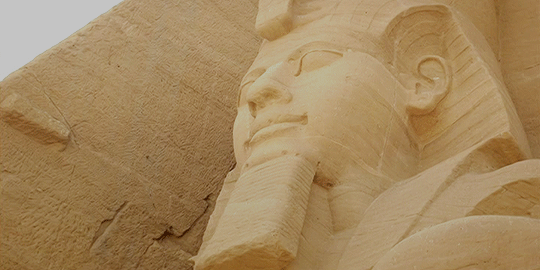

Abu Simbel is a historic site comprising two massive rock-cut temples in the village of Abu Simbel (Arabic: أبو سمبل), Aswan Governorate, Upper Egypt, near the border with Sudan. It is situated on the western bank of Lake Nasser, about 230 km (140 mi) southwest of Aswan (about 300 km (190 mi) by road).
The twin temples were originally carved out of the mountainside in the 13th century BC, during the 19th Dynasty reign of the Pharaoh Ramesses II. They serve as a lasting monument to the king Ramesses II. His wife Nefertari and children can be seen in smaller figures by his feet, considered to be of lesser importance and were not given the same position of scale. This commemorates his victory at the Battle of Kadesh. Their huge external rock relief figures have become iconic. [X]
275 notes
·
View notes
Text
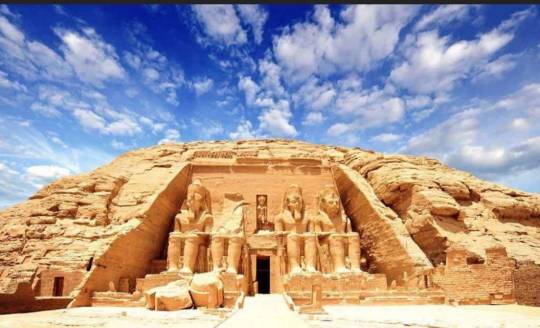
Great Temple of Ramses II
Abu Simbel, Egypt, Africa
... looks familiar ?
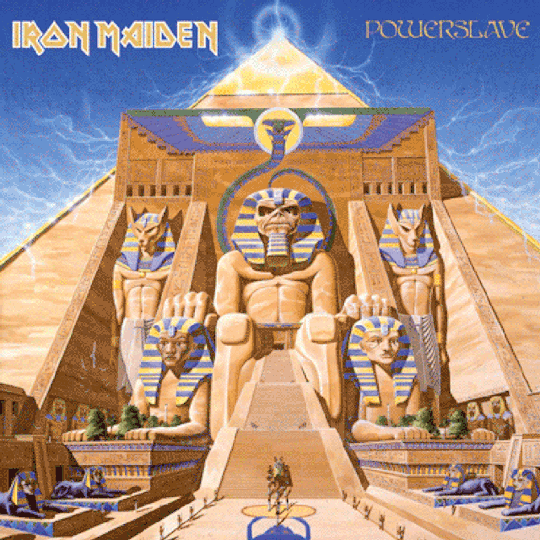
youtube
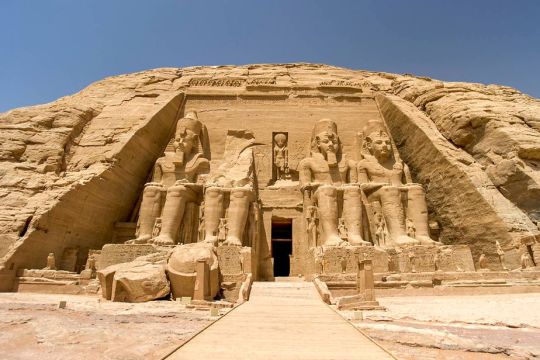
Carved out of the mountain on the west bank of the Nile between 1274 and 1244 BC, this imposing main temple of the Abu Simbel complex was as much dedicated to the deified Ramses II himself as to Ra-Horakhty, Amun and Ptah. The four colossal statues of the pharaoh, which front the temple, are like gigantic sentinels watching over the incoming traffic from the south, undoubtedly designed as a warning of the strength of the pharaoh.

Over the centuries both the Nile and the desert sands shifted, and this temple was lost to the world until 1813, when it was rediscovered by chance by the Swiss explorer Jean-Louis Burckhardt. Only one of the heads was completely showing above the sand, the next head was broken off and, of the remaining two, only the crowns could be seen. Enough sand was cleared away in 1817 by Giovanni Belzoni for the temple to be entered.

From the temple’s forecourt, a short flight of steps leads up to the terrace in front of the massive rock-cut facade, which is about 30m high and 35m wide. Guarding the entrance, three of the four famous colossal statues stare out across the water into eternity – the inner left statue collapsed in antiquity and its upper body still lies on the ground. The statues, more than 20m high, are accompanied by smaller statues of the pharaoh’s mother, Queen Tuya, his wife Nefertari and some of his favourite children. Above the entrance, between the central throned colossi, is the figure of the falcon-headed sun god Ra-Horakhty.
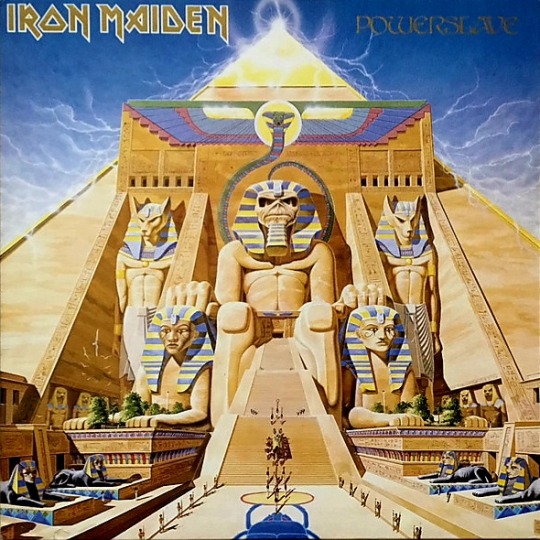

The roof of the large hall is decorated with vultures, symbolising the protective goddess Nekhbet, and is supported by eight columns, each fronted by an Osiride statue of Ramses II. Reliefs on the walls depict the pharaoh’s prowess in battle, trampling over his enemies and slaughtering them in front of the gods. On the north wall is a depiction of the famous Battle of Kadesh (c 1274 BC), in what is now Syria, where Ramses inspired his demoralised army so that they won the battle against the Hittites. The scene is dominated by a famous relief of Ramses in his chariot, shooting arrows at his fleeing enemies. Also visible is the Egyptian camp, walled off by its soldiers’ round-topped shields, and the fortified Hittite town, surrounded by the Orontes River.

The next hall, the four-columned vestibule where Ramses and Nefertari are shown in front of the gods and the solar barques, leads to the sacred sanctuary, where Ramses and the triad of gods of the Great Temple sit on their thrones.

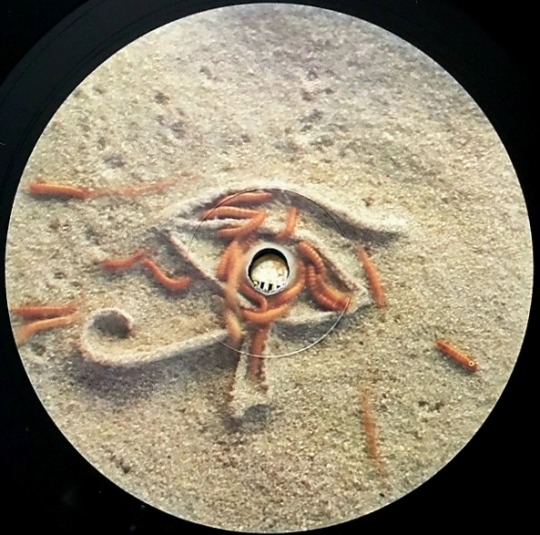
The original temple was aligned in such a way that each 21 February and 21 October, Ramses’ birthday and coronation day, the first rays of the rising sun moved across the hypostyle hall, through the vestibule and into the sanctuary, where they illuminate the figures of Ra-Horakhty, Ramses II and Amun. Ptah, to the left, was never supposed to be illuminated. Since the temples were moved, this phenomenon happens one day later.
youtube
20 notes
·
View notes
Text
‘Dr. Fell, we are very pleased to inform you that alongside the Westcar Papyrus and the Rhind Papyrus, the Actually We Won Papyrus will be known throughout history as one of the great finds of ancient Egyptian texts. Besides that, the Actually We Won Papyrus will be famous as the second-known example of Egyptian war propaganda, after the documentation from the Battle of Kadesh...’
“Bother,” Aziraphale muttered, as he stopped reading out loud. He adjusted his glasses very angrily. “Second? And here I thought I had invented propaganda!”
“Looks like the humans beat you to it,” Crowley shrugged. “At least I can still claim diplomacy.”
“Actually, if you read the rest of the letter, it goes into some depth on the diplomacy initiated around the Battle of Kadesh.”
“So I don’t even get that?” Crowley was offended. “All that work and the humans beat me to it?”
“By about 66 years. But you still got to claim it on your report to head office, that’s all that matters as far as we’re concerned.”
“...head office won’t like it when they find out I didn’t actually-”
“What did I tell you about telling the truth?” Aziraphale said tartly. “In fact, what did you yourself say about reports to head office?”
“That everyone stretches the truth a bit in reports to head office?”
“There, that’s a good angel. Now, let’s forget all about that ugliness while I draft a reply to these lovely gentlemen. Tea?”
“Please.”
x
#good omens#reverse omens#angel crowley#demon aziraphale#aziraphale x crowley#ineffable husbands#crowley is an ordinary angel#aziraphale is the seventh prince of hell and the lord of the octopuses#the seventh prince of hell
11 notes
·
View notes
Text
and now a bit of linguistic lore:
Sutekh adjusts to linguistic changes the quickest. He seems to pick up colloquialisms and language shifts almost immediately after they spread among the people of Kemet.
Djehuty, on the other hand, DESPISES LANGUAGE SHIFTS with EVERY FIBER OF HIS BEING. During the Battle of Kadesh story, which takes place firmly in the Late Bronze Age, Djehuty is still speaking Middle Egyptian and sounds like an ass.
Suty, on the other hand? The second the Kemetic language shifted toward analytic, he was all over it. Who needs to conjugate a verb when you have a handy preposition to get the job done?
#sutekh#djehuty#papyrusnabayat#bronze gods#headcanon#egyptian mythology#mythological fiction#egyptian language#lore
7 notes
·
View notes
Note
Hi Ava, first of all lemme tell you, I love your posts 💜
I'm curious about a hieratic version of Set's glyph you posted some time ago, probably last year, dating from the 19th dynasty... I was wondering if you happen to know where exactly it comes from.
I'm asking because I find it utterly beautiful, and I'd love to learn more about it.
Thank you in advance, hope you have a good day! 💜
It's from part of the Poem of the Battle of Kadesh, which is just absolutely gorgeous in general. If you look at these pictures on the British Museum's website (it's currently in their basement somewhere) you can see him on the eighth line, over to the left.
Also this other part of the poem has little horses drawn on the top of the page.
Thanks for the ask!
2 notes
·
View notes
Text
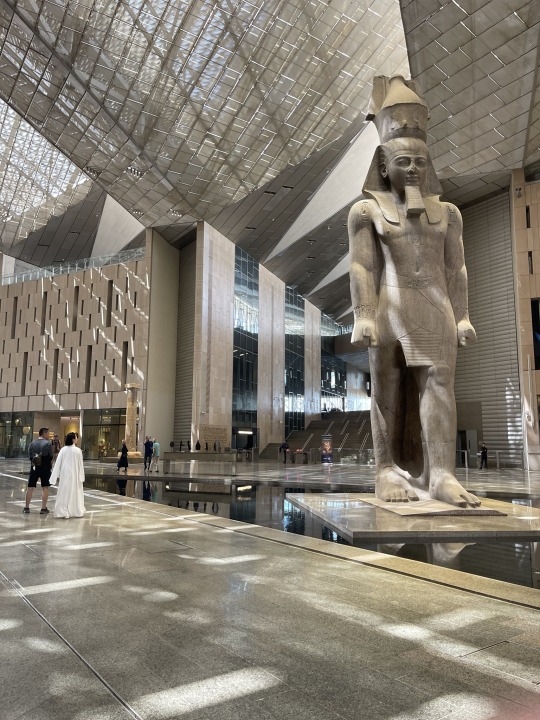
.
The pièce de résistance at The Grand Egyptian Museum… Ramses II
The Statue of Ramesses II is a 3,200-year-old figure of Ramesses II, depicting him standing. It was discovered in 1820 by Giovanni Battista Caviglia at the Great Temple of Ptah near Memphis, Egypt. It is made from limestone and weighs 83 tons. This statue was built to celebrate the victory over the Hittites in the Battle of Kadesh in 1274 B.C.
The statue was found broken in six pieces. In 1955, Egyptian Prime Minister Gamal Abdel Nasser moved it to the large Bab Al-Hadid Square in Cairo, outside Cairo's main railway station. There the statue was restored to its full height of 11 meters and erected on a three-metre pedestal at the edge of a fountain. It was stabilized by iron bars inside the body.
Over time Ramses Square turned out to be an unsuitable location, as the statue was exposed to corrosive pollution and constant vibration from traffic and subways. The Egyptian government decided to relocate it to a more appropriate location in 2006. At a temporary site on the Giza Plateau it underwent restoration before being moved to the Grand Egyptian Museum (GEM) in Giza in 2018.
The transportation of the statue from Ramses Square to Giza was a technological challenge that had been in the planning since 2002. A replica had been made and was transported several weeks before the scheduled actual move along the planned route to Giza to test the proposed relocation process. The move took place on August 25, 2006. During its ten-hour transport the statue was wrapped and covered in rubber foam. Two flat-back trucks carried the weight of the statue and its support structures as it travelled in a vertical position.
3 notes
·
View notes